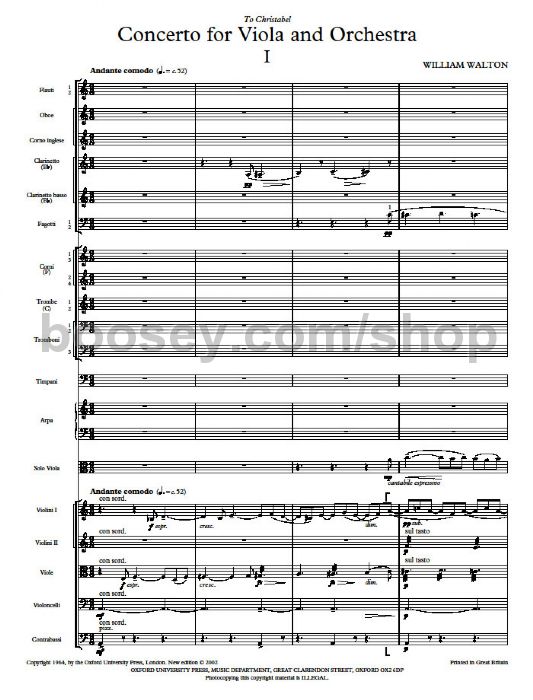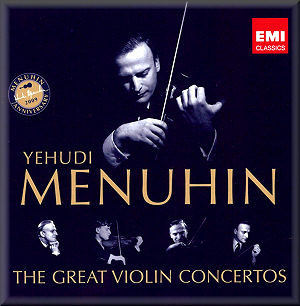The Violin Concerto of William Walton was written in 1938–39 and dedicated to Jascha Heifetz, who performed it at its premiere on 7 December 1939 in Cleveland.Walton later re-orchestrated the concerto in 1943. This edition of Walton's Violin Concerto has been off-printed from the William Walton Edition full score, and combines the scholarship of the Edition (including an introduction by the editor) with the practical benefits of a study score format. Commissioned by Jascha Heifetz, the work was completed in 1939 and premiered by Heifetz later that year.
Blackhawk floor jack parts manual. All returns must include a copy of the receipt or no credit will be issued. Returns are subject to a 20% restocking charge.
The Viola Concerto by William Walton was written in 1929 for the violist Lionel Tertis at the suggestion of the conductor Sir Thomas Beecham.[1] The concerto carries the dedication 'To Christabel' (Christabel McLaren, Lady Aberconway). But Tertis rejected the manuscript, and composer and violist Paul Hindemith gave the first performance. The work was greeted with enthusiasm. It brought Walton to the forefront of British classical music. In The Manchester Guardian, Eric Blom wrote, 'This young composer is a born genius' and said that it was tempting to call the concerto the best thing in recent music of any nationality.[2] Tertis soon changed his mind and took the work up.
Myst 3 exile download free pc. Myst III: Exile Free Download PC Game Cracked in Direct Link and Torrent. Myst III: Exile is an adventure puzzle video games. Myst 3 Exile Download new game pc iso, Repack pc game, Crack game pc gog, Direct link game pc, Download full iso game pc vr. The story picks up after the events in Myst, Riven, and the Myst-based novels (The Book of Atrus, The Book of Ti’ana, and The Book of D’ni).
Walton and Hindemith's collaboration on the concerto engendered a close friendship that lasted until the latter's death in 1963. A performance by Tertis at a Three Choirs Festival concert in Worcester in 1932 was the only occasion on which Walton met Edward Elgar, whom he greatly admired. Elgar, however, did not share the general enthusiasm for Walton's concerto.[3][4]
Structure[edit]
Superficially, the work follows the standard three-movement format for a concerto. However, the tempo marks hint at some important differences:
- Andante comodo
- Vivo, con molto preciso
- Allegro moderato
Ordinarily, the first and third movements of a concerto are in fast tempi, while the second movement is slow. Here, the first movement is on the slow side, and the second movement is unequivocally fast. In terms of character, the second movement is scherzo-like. Few concerti include a scherzo, but Walton's Viola Concerto seems to have been modeled on Prokofiev's First Violin Concerto, which Walton admired. Prokofiev's concerto also has a scherzo for its second movement as well as a relatively slow-moving first movement.
Composition[edit]
Walton composed his Viola Concerto at the suggestion of conductor Sir Thomas Beecham for violist Lionel Tertis. Tertis had served as principal violist in Beecham's orchestra. Beecham, however, had not heard any of Walton's music.[5] Walton wrote in December 1928 that he was 'working hard' on the piece and in February 1929 that he had finished the second movement. He wrote that he considered the concerto potentially his finest work to date; whether this assessment would hold true, he added, depended on how the third movement turned out. He completed the work by the middle of 1929.[6]
Premiere and subsequent performances[edit]
When Tertis received the manuscript for the concerto, he rejected the work as too modernistic for his taste. As he later wrote in this autobiography,
One work of which I did not give the first performance was Walton's masterly concerto. With shame and contrition I admit that when the composer offered me the first performance I declined it. I was unwell at the time; but what is also true is that I had not learnt to appreciate Walton's style. The innovations in his musical language, which now seem so logical and so truly in the mainstream of music, then struck me as far-fetched.
The composer was so disappointed by Tertis' refusal that he considered recasting the concerto for violin and orchestra.[5] Conductor and BBC programme planner Edward Clark suggested German composer and violist Paul Hindemith as a substitute for Tertis. (Tertis also claimed to have suggested Hindemith when he declined the premiere, but Walton confirmed it was Clark's idea.[7]) Trained in the German school of string playing, Hindemith did not possess an immaculate technique. However, he played with strong character, a full tone and great emotion.[8] The composer later wrote that Hindemith's 'technique was marvelous, but he was rough—no nonsense about it. He just stood up and played.'[9]
Walton was initially somewhat reluctant to invite Hindemith, as he felt he had modelled the concerto too closely after the latter's style, which he would quickly recognise; but thanks to Edward Clark, the invitation was sent and accepted, the premiere was successful.[10][11] This was the only time Hindemith performed Walton's work. When he returned to Great Britain in 1930, he performed his own viola concerto.[12] The premiere was given on 3 October 1929 with the composer conducting.[13] The occasion was a Prom Concert at the Queen's Hall, with the Henry Wood Symphony Orchestra, a scratch orchestra consisting mainly of women.[14][15][16] Tertis, who attended the premiere, realized that he had made a mistake in rejecting the concerto and soon took up the work.[12]
The first recording was made on 6 December 1937 by Frederick Riddle, with the composer conducting.[17] Riddle was recommended for this recording by Tertis. He also made some revisions to the concerto, with Walton's approval.[13] Although Walton conducted the work many times with leading soloists such as Tertis and William Primrose, the interpretation he liked above all others was that of Frederick Riddle; he asked Riddle to submit his edited manuscript to Oxford University Press, and this became the officially published version between 1938 and 1961.[1]
William Primrose first played the concerto on 27 February 1936, in a concert under Sir Thomas Beecham. For this, Primrose rewrote some passages in all three movements, apparently with Walton's approval; he always played this version in concert and in both of his recordings. Walton published a revised version in 1964, but it contained none of Primrose's changes. Walton later confirmed he preferred his original conception rather than the one with Primrose's emendations.[14]
Sterling serial number nomenclature. Numerous other recordings have been made of the piece, by such violists as Yuri Bashmet, Nobuko Imai, Paul Neubauer and William Primrose. Many soloists better known for their violin playing have also recorded the concerto, including Nigel Kennedy, Maxim Vengerov, and Yehudi Menuhin.
Orchestration revision[edit]
The orchestration of the concerto was revised in 1961 by Walton, with the premiere of the revised version being performed by John Coulling accompanied by the London Philharmonic Orchestra under Sir Malcolm Sargent on 18 January 1962.[13]
The revised orchestration features 2 flutes (second doubling piccolo), oboe, cor anglais, 2 clarinets (second doubling bass clarinet), 2 bassoons, 4 horns, 2 trumpets, 3 trombones, timpani, harp and strings, compared to the original of 2 flutes, piccolo, 2 oboes, cor anglais, 2 clarinets, bass clarinet, 2 bassoons, contrabassoon, 4 horns, 3 trumpets, 3 trombones, tuba, timpani and strings.
William Walton Violin Concerto
Walton did not withdraw the earlier version, but did express a preference for the revised orchestration. Consequently, it is this version that is typically performed.[18] However, the original version has been recorded by Lawrence Power.[19]
AppRemover is completely portable (meaning you can use it without installing it) and it can remove a list of program at the same time, making it a Batch Uninstall Tool. While you're running it, the application will display a progress bar and text informing you of current operations. AppRemover program to remove unnecessary anti-virus, anti-spyware and other software that enhance the PC security.AppRemover can be particularly useful in cases such as the inability to remove the software with standard means, for example, in the case of loss of password management that software, as well as to remove all traces of previously. Oct 28, 2015 AppRemover holds the ranking of 5 in its category and holds the position number 989 in Uptodown’s overall ranking. Some similar programs are: Revo Uninstaller, Junkware Removal Tool, GeekUninstaller, Revo Uninstaller Portable. Download app remover portable air compressor. AppRemover, free and safe download. AppRemover latest version: Clean security software from your system. Download AppRemover 3.1.8.1 Portable or any other file from Applications category. HTTP download also available at fast speeds.

Friendship with Hindemith[edit]
Walton's work with Hindemith in preparing the Viola Concerto for its premiere began a close friendship between the two men that lasted until Hindemith's death in 1963. Just before Hindemith's death, Walton composed a set of variations on a theme from Hindemith's Cello Concerto. This work also included references to Hindemith's opera Mathis der Maler. Both the music and the recognition from which it had been inspired greatly pleased Hindemith.[20]
References[edit]
- ^ abDunham, James. 'The Walton Viola Concerto: A Synthesis'(PDF). Journal of the American Viola Society. 22 (1). Archived from the original(PDF) on 13 July 2011. Retrieved 9 June 2011.Cite uses deprecated parameter
|dead-url=(help) - ^'A Fine British Concert', The Manchester Guardian, 22 August 1930, p. 5, reviewing the second London performance.
- ^Kennedy, p. 52
- ^Tertis had premiered Elgar's own 'Viola Concerto' two years earlier – an arrangement of the Cello Concerto for the viola. See The Musical Times, April 1934, p. 318
- ^ abLloyd, 89
- ^Lloyd, 90
- ^Stephen Lloyd, William Walton: Muse of Fire
- ^Morin, 1149
- ^Lloyd, 93
- ^Michael Steinberg, The Concerto: A Listener's Guide
- ^Philip Reed, On Mahler and Britten: Essays in Honour of Donald Mitchell on His Seventieth
- ^ abLloyd, 94
- ^ abc'Walton: Concerto for Viola and Orchestra'. Archived from the original on 2010-06-16. Retrieved 2010-06-16.Cite uses deprecated parameter
|dead-url=(help) - ^ abStephen Lloyd, William Walton: Muse of Fire
- ^Michael Thomas Roeder, A History of the Concerto
- ^Paul Hindemith, Selected Letters
- ^Answers.com
- ^'Walton Viola Concerto programme notes'. Archived from the original on 2008-08-27. Retrieved 2008-06-23.Cite uses deprecated parameter
|dead-url=(help) - ^Liner notes for Hyperion Records CDA67587.
- ^Roeder, 334

Sources[edit]
- Lloyd, Stephen, William Walton: Muse of Fire (Woodbridge, Suffolk and Rochester, New York: Boydell Press, 2001), ISBN0-85115-803-X
- Morin, Alexander J. ed., Classical Music: The Listener's Companion (San Francisco: Backbeat Books, 2002), ISBN0-87930-638-6
- Roeder, Michael Thomas, A History of the Concerto (Portland, Oregon: Amadeus Press, 1994), ISBN0-931340-61-6